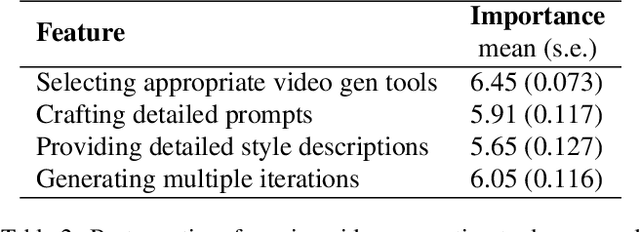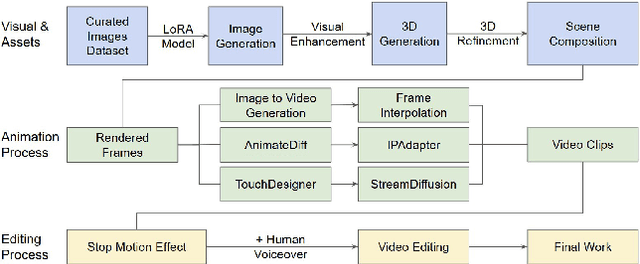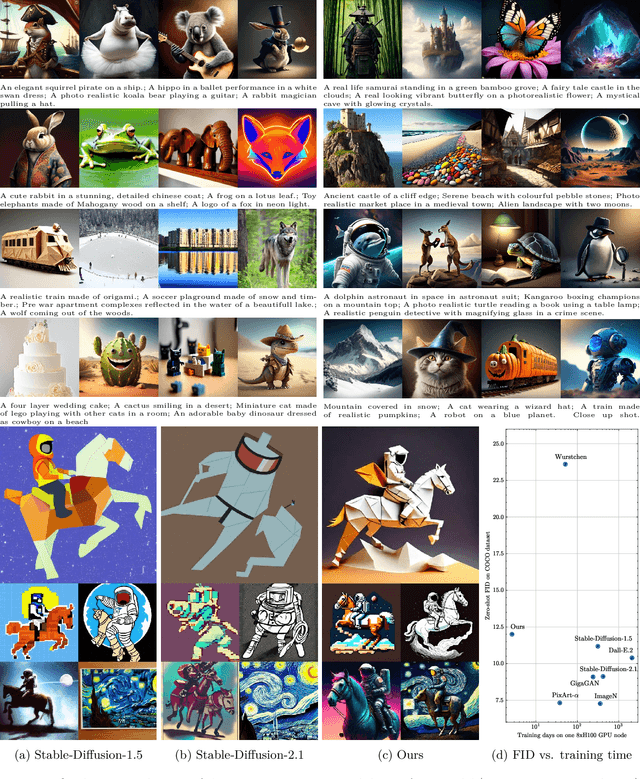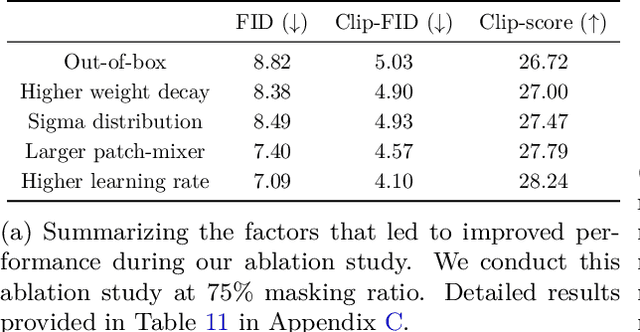Xianghao Kong
Taming Flow-based I2V Models for Creative Video Editing
Sep 26, 2025Abstract:Although image editing techniques have advanced significantly, video editing, which aims to manipulate videos according to user intent, remains an emerging challenge. Most existing image-conditioned video editing methods either require inversion with model-specific design or need extensive optimization, limiting their capability of leveraging up-to-date image-to-video (I2V) models to transfer the editing capability of image editing models to the video domain. To this end, we propose IF-V2V, an Inversion-Free method that can adapt off-the-shelf flow-matching-based I2V models for video editing without significant computational overhead. To circumvent inversion, we devise Vector Field Rectification with Sample Deviation to incorporate information from the source video into the denoising process by introducing a deviation term into the denoising vector field. To further ensure consistency with the source video in a model-agnostic way, we introduce Structure-and-Motion-Preserving Initialization to generate motion-aware temporally correlated noise with structural information embedded. We also present a Deviation Caching mechanism to minimize the additional computational cost for denoising vector rectification without significantly impacting editing quality. Evaluations demonstrate that our method achieves superior editing quality and consistency over existing approaches, offering a lightweight plug-and-play solution to realize visual creativity.
ProFashion: Prototype-guided Fashion Video Generation with Multiple Reference Images
May 10, 2025Abstract:Fashion video generation aims to synthesize temporally consistent videos from reference images of a designated character. Despite significant progress, existing diffusion-based methods only support a single reference image as input, severely limiting their capability to generate view-consistent fashion videos, especially when there are different patterns on the clothes from different perspectives. Moreover, the widely adopted motion module does not sufficiently model human body movement, leading to sub-optimal spatiotemporal consistency. To address these issues, we propose ProFashion, a fashion video generation framework leveraging multiple reference images to achieve improved view consistency and temporal coherency. To effectively leverage features from multiple reference images while maintaining a reasonable computational cost, we devise a Pose-aware Prototype Aggregator, which selects and aggregates global and fine-grained reference features according to pose information to form frame-wise prototypes, which serve as guidance in the denoising process. To further enhance motion consistency, we introduce a Flow-enhanced Prototype Instantiator, which exploits the human keypoint motion flow to guide an extra spatiotemporal attention process in the denoiser. To demonstrate the effectiveness of ProFashion, we extensively evaluate our method on the MRFashion-7K dataset we collected from the Internet. ProFashion also outperforms previous methods on the UBC Fashion dataset.
Generative AI for Film Creation: A Survey of Recent Advances
Apr 11, 2025



Abstract:Generative AI (GenAI) is transforming filmmaking, equipping artists with tools like text-to-image and image-to-video diffusion, neural radiance fields, avatar generation, and 3D synthesis. This paper examines the adoption of these technologies in filmmaking, analyzing workflows from recent AI-driven films to understand how GenAI contributes to character creation, aesthetic styling, and narration. We explore key strategies for maintaining character consistency, achieving stylistic coherence, and ensuring motion continuity. Additionally, we highlight emerging trends such as the growing use of 3D generation and the integration of real footage with AI-generated elements. Beyond technical advancements, we examine how GenAI is enabling new artistic expressions, from generating hard-to-shoot footage to dreamlike diffusion-based morphing effects, abstract visuals, and unworldly objects. We also gather artists' feedback on challenges and desired improvements, including consistency, controllability, fine-grained editing, and motion refinement. Our study provides insights into the evolving intersection of AI and filmmaking, offering a roadmap for researchers and artists navigating this rapidly expanding field.
Stretching Each Dollar: Diffusion Training from Scratch on a Micro-Budget
Jul 22, 2024



Abstract:As scaling laws in generative AI push performance, they also simultaneously concentrate the development of these models among actors with large computational resources. With a focus on text-to-image (T2I) generative models, we aim to address this bottleneck by demonstrating very low-cost training of large-scale T2I diffusion transformer models. As the computational cost of transformers increases with the number of patches in each image, we propose to randomly mask up to 75% of the image patches during training. We propose a deferred masking strategy that preprocesses all patches using a patch-mixer before masking, thus significantly reducing the performance degradation with masking, making it superior to model downscaling in reducing computational cost. We also incorporate the latest improvements in transformer architecture, such as the use of mixture-of-experts layers, to improve performance and further identify the critical benefit of using synthetic images in micro-budget training. Finally, using only 37M publicly available real and synthetic images, we train a 1.16 billion parameter sparse transformer with only \$1,890 economical cost and achieve a 12.7 FID in zero-shot generation on the COCO dataset. Notably, our model achieves competitive FID and high-quality generations while incurring 118$\times$ lower cost than stable diffusion models and 14$\times$ lower cost than the current state-of-the-art approach that costs \$28,400. We aim to release our end-to-end training pipeline to further democratize the training of large-scale diffusion models on micro-budgets.
Your Diffusion Model is Secretly a Noise Classifier and Benefits from Contrastive Training
Jul 12, 2024



Abstract:Diffusion models learn to denoise data and the trained denoiser is then used to generate new samples from the data distribution. In this paper, we revisit the diffusion sampling process and identify a fundamental cause of sample quality degradation: the denoiser is poorly estimated in regions that are far Outside Of the training Distribution (OOD), and the sampling process inevitably evaluates in these OOD regions. This can become problematic for all sampling methods, especially when we move to parallel sampling which requires us to initialize and update the entire sample trajectory of dynamics in parallel, leading to many OOD evaluations. To address this problem, we introduce a new self-supervised training objective that differentiates the levels of noise added to a sample, leading to improved OOD denoising performance. The approach is based on our observation that diffusion models implicitly define a log-likelihood ratio that distinguishes distributions with different amounts of noise, and this expression depends on denoiser performance outside the standard training distribution. We show by diverse experiments that the proposed contrastive diffusion training is effective for both sequential and parallel settings, and it improves the performance and speed of parallel samplers significantly.
Controllable Navigation Instruction Generation with Chain of Thought Prompting
Jul 10, 2024Abstract:Instruction generation is a vital and multidisciplinary research area with broad applications. Existing instruction generation models are limited to generating instructions in a single style from a particular dataset, and the style and content of generated instructions cannot be controlled. Moreover, most existing instruction generation methods also disregard the spatial modeling of the navigation environment. Leveraging the capabilities of Large Language Models (LLMs), we propose C-Instructor, which utilizes the chain-of-thought-style prompt for style-controllable and content-controllable instruction generation. Firstly, we propose a Chain of Thought with Landmarks (CoTL) mechanism, which guides the LLM to identify key landmarks and then generate complete instructions. CoTL renders generated instructions more accessible to follow and offers greater controllability over the manipulation of landmark objects. Furthermore, we present a Spatial Topology Modeling Task to facilitate the understanding of the spatial structure of the environment. Finally, we introduce a Style-Mixed Training policy, harnessing the prior knowledge of LLMs to enable style control for instruction generation based on different prompts within a single model instance. Extensive experiments demonstrate that instructions generated by C-Instructor outperform those generated by previous methods in text metrics, navigation guidance evaluation, and user studies.
Asymmetric Bias in Text-to-Image Generation with Adversarial Attacks
Dec 22, 2023Abstract:The widespread use of Text-to-Image (T2I) models in content generation requires careful examination of their safety, including their robustness to adversarial attacks. Despite extensive research into this, the reasons for their effectiveness are underexplored. This paper presents an empirical study on adversarial attacks against T2I models, focusing on analyzing factors associated with attack success rates (ASRs). We introduce a new attack objective - entity swapping using adversarial suffixes and two gradient-based attack algorithms. Human and automatic evaluations reveal the asymmetric nature of ASRs on entity swap: for example, it is easier to replace "human" with "robot" in the prompt "a human dancing in the rain." with an adversarial suffix but is significantly harder in reverse. We further propose probing metrics to establish indicative signals from the model's beliefs to the adversarial ASR. We identify conditions resulting in a 60% success probability for adversarial attacks and others where this likelihood drops below 5%.
DUSA: Decoupled Unsupervised Sim2Real Adaptation for Vehicle-to-Everything Collaborative Perception
Oct 12, 2023Abstract:Vehicle-to-Everything (V2X) collaborative perception is crucial for autonomous driving. However, achieving high-precision V2X perception requires a significant amount of annotated real-world data, which can always be expensive and hard to acquire. Simulated data have raised much attention since they can be massively produced at an extremely low cost. Nevertheless, the significant domain gap between simulated and real-world data, including differences in sensor type, reflectance patterns, and road surroundings, often leads to poor performance of models trained on simulated data when evaluated on real-world data. In addition, there remains a domain gap between real-world collaborative agents, e.g. different types of sensors may be installed on autonomous vehicles and roadside infrastructures with different extrinsics, further increasing the difficulty of sim2real generalization. To take full advantage of simulated data, we present a new unsupervised sim2real domain adaptation method for V2X collaborative detection named Decoupled Unsupervised Sim2Real Adaptation (DUSA). Our new method decouples the V2X collaborative sim2real domain adaptation problem into two sub-problems: sim2real adaptation and inter-agent adaptation. For sim2real adaptation, we design a Location-adaptive Sim2Real Adapter (LSA) module to adaptively aggregate features from critical locations of the feature map and align the features between simulated data and real-world data via a sim/real discriminator on the aggregated global feature. For inter-agent adaptation, we further devise a Confidence-aware Inter-agent Adapter (CIA) module to align the fine-grained features from heterogeneous agents under the guidance of agent-wise confidence maps. Experiments demonstrate the effectiveness of the proposed DUSA approach on unsupervised sim2real adaptation from the simulated V2XSet dataset to the real-world DAIR-V2X-C dataset.
Interpretable Diffusion via Information Decomposition
Oct 12, 2023Abstract:Denoising diffusion models enable conditional generation and density modeling of complex relationships like images and text. However, the nature of the learned relationships is opaque making it difficult to understand precisely what relationships between words and parts of an image are captured, or to predict the effect of an intervention. We illuminate the fine-grained relationships learned by diffusion models by noticing a precise relationship between diffusion and information decomposition. Exact expressions for mutual information and conditional mutual information can be written in terms of the denoising model. Furthermore, pointwise estimates can be easily estimated as well, allowing us to ask questions about the relationships between specific images and captions. Decomposing information even further to understand which variables in a high-dimensional space carry information is a long-standing problem. For diffusion models, we show that a natural non-negative decomposition of mutual information emerges, allowing us to quantify informative relationships between words and pixels in an image. We exploit these new relations to measure the compositional understanding of diffusion models, to do unsupervised localization of objects in images, and to measure effects when selectively editing images through prompt interventions.
Towards Vehicle-to-everything Autonomous Driving: A Survey on Collaborative Perception
Aug 31, 2023



Abstract:Vehicle-to-everything (V2X) autonomous driving opens up a promising direction for developing a new generation of intelligent transportation systems. Collaborative perception (CP) as an essential component to achieve V2X can overcome the inherent limitations of individual perception, including occlusion and long-range perception. In this survey, we provide a comprehensive review of CP methods for V2X scenarios, bringing a profound and in-depth understanding to the community. Specifically, we first introduce the architecture and workflow of typical V2X systems, which affords a broader perspective to understand the entire V2X system and the role of CP within it. Then, we thoroughly summarize and analyze existing V2X perception datasets and CP methods. Particularly, we introduce numerous CP methods from various crucial perspectives, including collaboration stages, roadside sensors placement, latency compensation, performance-bandwidth trade-off, attack/defense, pose alignment, etc. Moreover, we conduct extensive experimental analyses to compare and examine current CP methods, revealing some essential and unexplored insights. Specifically, we analyze the performance changes of different methods under different bandwidths, providing a deep insight into the performance-bandwidth trade-off issue. Also, we examine methods under different LiDAR ranges. To study the model robustness, we further investigate the effects of various simulated real-world noises on the performance of different CP methods, covering communication latency, lossy communication, localization errors, and mixed noises. In addition, we look into the sim-to-real generalization ability of existing CP methods. At last, we thoroughly discuss issues and challenges, highlighting promising directions for future efforts. Our codes for experimental analysis will be public at https://github.com/memberRE/Collaborative-Perception.
 Add to Chrome
Add to Chrome Add to Firefox
Add to Firefox Add to Edge
Add to Edge